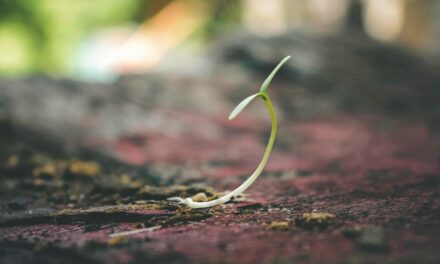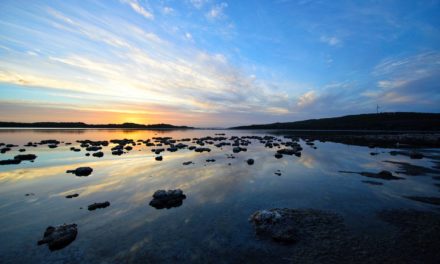If you stand by the apple tree and turn toward the east you will see two walls terracing the hillside, the lower one, a gentle curve of native Ohio stone laid up with mortar and holding up an herb garden, then above it is a straight retaining wall of stacked cast stone, holding up a plane of gravel for parking the cars. I built the second wall last year. My father-in-law built the first one 30 years ago, when he was about the age I am now.
During the weeks I spent working on my wall, he spent dying in nearby medical facilities. I laid up my wall from right to left so that the last problem to solve was how to join the two walls where his arc met my line at the northeast end. While placing the last stone, I hit my thumb with a rubber mallet, and he died, or so we later determined when the phone call came.
The two walls, together and separately, sustain small patches of the horizontal on an incline slumping slowly towards the Cuyahoga River, which you cannot see from here, but it is the sculptor of this valley.
When the Israelites crossed the Jordan River and marched around the Canaanite city of Jericho, they were faced with stone retaining walls, to keep the place from slumping towards the Jordan, and above that they saw mud brick defensive walls climbing to the sky. This thought makes me glad I donated our trumpet to the Goodwill. Also, the thought of our Toyota parked in the clouds seems scary and impractical. Neither of our walls would keep out the ferocious Israelites, or even visiting tomcats intent on spraying our tires, but they do the main job of holding back the earth, the herbs imported from other gardens, and two vehicles, as well as memories of other times.
I dug the footer for his wall, back when I was young and clueless, and mixed some of the mortar. He set up his portable radio, tuned to the classical station, and hauled stone after stone from his old pickup truck, dressed them with his mason tools and laid them one after another, day after day, until the wall was done. Like most young men, I was not yet capable of appreciating the extent of his gift because I did not yet know what lifting stone after stone does to the 60-year-old body. And yet, then and now, I understand the need to give it all for a daughter. My own adult daughter and her husband live just across the river from here, and I never pass up the opportunity to leave semi-permanent reminders around her home that I once lived, that I once was young enough to heft a stone or handle a hammer. My son-in-law and I have worked this out, just as I had to work it out with my father-in-law, this problem of loving the same woman in such different ways, the problem of respecting each other beneath the walls of her Jericho.
There are rice terraces in China as old as civilization, climbing the mountains like so many cupped hands, each holding a small world of frogs, fish, ducks, and the grassy staff of life. In the Andes, such terracing was done by civilizations that were older than memory when the Inca arrived, and where potatoes, maize and quinoa grew enough to feed everyone. And in North America there were millions of beaver dams, wattle and daub structures meant to retain water but eventually silting in to become millions of meadows, those little flat places holding back the steady movement of the mountains to the sea. For it is time itself we try to hold back when we build these walls, we humans and beavers and insects that labor so in the wilderness.
When that first artist in those French caves spread his hand on the rocky surface and blew a spray of pigment from his mouth, he left a retaining wall of color around the image of that hand that has lasted 30000 years, holding back an image that otherwise would have slumped into the background as soon as he pulled the hand away, like the dreams she records on her bedside tablet, she who sleeps beside me, the ephemeral dreams that would vanish like smoke if she did not take a moment to spray words around them.
Poetic forms, as old as any agricultural walls, have been holding back the erosion of ancient wisdom, like the songs of Homer and the Hebrew Bible, with sturdy hexameters and flexible psalms. It is in our nature to assign meaning and hold back the entropy. When I go to bed and turn off the light and close my eyes I see mountains in the distance on the inside of my eyelids, complete with mysterious valleys of red light fading to black, and even though I have no shaping tools other than rapid eye movements, I find myself building walls to save pools of light, lovely red light in my cupped hands and trickling through my fingers as I slump to the river of sleep.







This is one of the best pieces I have ever read. And a most wonderful eulogy. Truly.
I am a hospital chaplain and a writer/poet, and I look for words that weave the two together. I find, in that combination, the depth I have learned I must have. Depth of feeling, of discernment, of analogy in it’s most storied form. “Where his arc met my straight line,” sums up all relationships. Perhaps it sums up everything. I could teach a course on this line, on the whole poem.
I am a Quaker from the tradition of silent Friends, and we know that when there is difficulty finding words adequate to a personal experience, one has encountered the Almighty One.. There are no words big enough to describe that event, as there are no words to describe being in the presence of God (or Goddess.) But your walls created a sacred space, where what is wonderfully human can meet what is wonderfully profound.
Such a peace/piece! A mighty work. My words cannot do it justice.